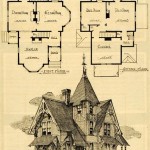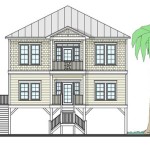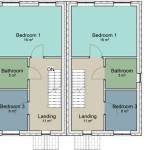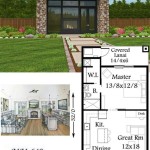Flat roof house plans are a type of architectural design that features a roof that is flat or nearly flat. These plans are often used in contemporary and modern architecture, and they can offer a number of advantages, such as increased energy efficiency, reduced maintenance costs, and a more streamlined appearance. One example of a flat roof house plan is the Bauhaus style, which was popular in the early 20th century and is characterized by its clean lines, simple geometric shapes, and flat roof.
Flat roof house plans are not without their drawbacks, however. One potential problem is that they can be more susceptible to leaks than pitched roofs. Additionally, flat roofs can collect water and snow, which can lead to problems with drainage and ice dams. However, these problems can be mitigated with proper design and construction techniques.
Flat roof house plans offer a number of advantages, including:
- Increased energy efficiency
- Reduced maintenance costs
- More streamlined appearance
- Increased usable space
- Easier to build than pitched roofs
- Can be used to create rooftop gardens or terraces
- Can help to reduce noise pollution
- Can be more resistant to high winds
However, it is important to note that flat roof house plans also have some drawbacks, such as:
Increased energy efficiency
Flat roof house plans can offer increased energy efficiency due to a number of factors, including:
- Reduced heat loss: Flat roofs are typically better insulated than pitched roofs, which can help to reduce heat loss in the winter. This is because flat roofs have a smaller surface area than pitched roofs, which means that there is less area for heat to escape. Additionally, flat roofs can be more easily sealed than pitched roofs, which can help to prevent air leaks that can lead to heat loss.
- Increased solar gain: Flat roofs can be used to collect solar energy, which can be used to heat the home in the winter and cool the home in the summer. This can be done by installing solar panels on the roof or by using a passive solar design, which uses the sun’s heat to warm the home through windows and other openings.
- Improved airflow: Flat roofs can help to improve airflow in the home, which can help to reduce energy costs. This is because flat roofs allow air to circulate more easily than pitched roofs, which can help to keep the home cooler in the summer and warmer in the winter.
- Reduced maintenance costs: Flat roofs typically require less maintenance than pitched roofs, which can save money in the long run. This is because flat roofs are less likely to leak or develop other problems, and they are easier to clean and repair.
As a result of these factors, flat roof house plans can offer significant energy savings over pitched roof house plans. In some cases, flat roof house plans can even achieve net-zero energy consumption, which means that they produce as much energy as they consume.
Reduced maintenance costs
Flat roof house plans typically require less maintenance than pitched roof house plans, which can save money in the long run. This is because flat roofs are less likely to leak or develop other problems, and they are easier to clean and repair.
- Less likely to leak: Flat roofs are less likely to leak than pitched roofs because they have fewer seams and joints. This is because flat roofs are typically made from a single sheet of material, such as rubber or PVC, which is then sealed at the seams. Pitched roofs, on the other hand, are made from multiple pieces of material that are overlapped and sealed together, which creates more opportunities for leaks to develop.
- Easier to clean and repair: Flat roofs are also easier to clean and repair than pitched roofs. This is because flat roofs are more accessible than pitched roofs, and they do not have any steep slopes that can be difficult to reach. Additionally, flat roofs are typically made from materials that are easy to clean and repair, such as rubber or PVC.
As a result of these factors, flat roof house plans can offer significant savings on maintenance costs over pitched roof house plans. In some cases, the savings on maintenance costs can even offset the higher initial cost of a flat roof house plan.
More streamlined appearance
Flat roof house plans offer a more streamlined appearance than pitched roof house plans. This is because flat roofs have fewer rooflines and valleys, which can create a more clean and modern look. Additionally, flat roofs can be used to create rooftop terraces or gardens, which can further enhance the home’s appearance.
- Clean lines: Flat roofs have clean lines and simple geometric shapes, which can create a more modern and minimalist look. This is in contrast to pitched roofs, which can have complex rooflines and valleys, which can create a more traditional look.
- Reduced visual clutter: Flat roofs have less visual clutter than pitched roofs, which can make the home appear more spacious and inviting. This is because flat roofs do not have any dormers or other roof projections that can break up the roofline. Additionally, flat roofs can be used to hide mechanical equipment, such as HVAC units and solar panels, which can further reduce visual clutter.
- Increased curb appeal: Flat roof house plans can have increased curb appeal over pitched roof house plans. This is because flat roofs can be used to create unique and eye-catching designs. For example, flat roofs can be used to create rooftop gardens or terraces, which can add a touch of luxury and sophistication to the home. Additionally, flat roofs can be used to create cantilevered roofs, which can create a dramatic and modern look.
- Improved indoor-outdoor flow: Flat roofs can be used to create seamless indoor-outdoor flow. This is because flat roofs can be easily connected to outdoor spaces, such as patios and decks. Additionally, flat roofs can be used to create rooftop terraces or gardens, which can provide a private and secluded outdoor space.
As a result of these factors, flat roof house plans can offer a more streamlined and modern appearance than pitched roof house plans. This can make flat roof house plans a good choice for homeowners who want a home that is both stylish and functional.
Increased usable space
Flat roof house plans offer increased usable space over pitched roof house plans. This is because flat roofs eliminate the wasted space that is created by sloped ceilings. In a pitched roof house plan, the sloped ceilings can make it difficult to use the space in the attic or loft. In a flat roof house plan, however, the entire roof space can be used as living space.
- More headroom: Flat roofs offer more headroom than pitched roofs. This is because flat roofs have no sloped ceilings, which means that there is more space to stand and move around. This can make flat roof house plans a good choice for people who are tall or who want to feel more spacious in their home.
- More usable attic space: Flat roofs can be used to create more usable attic space than pitched roofs. This is because flat roofs have more headroom and more floor space than pitched roofs. Additionally, flat roofs can be more easily accessed than pitched roofs, which makes it easier to use the attic space for storage or other purposes.
- More rooftop space: Flat roofs can be used to create more rooftop space than pitched roofs. This is because flat roofs have more surface area than pitched roofs. This additional space can be used to create rooftop gardens, terraces, or other outdoor living spaces.
- More flexibility: Flat roofs offer more flexibility than pitched roofs. This is because flat roofs can be used to create a variety of different floor plans and designs. For example, flat roofs can be used to create open floor plans, which are popular in modern architecture. Additionally, flat roofs can be used to create multi-story homes, which can be a good option for people who want to live in a smaller footprint.
As a result of these factors, flat roof house plans can offer significantly more usable space than pitched roof house plans. This can make flat roof house plans a good choice for people who want a home that is both spacious and functional.
Easier to build than pitched roofs
Flat roof house plans are generally easier to build than pitched roof house plans. This is because flat roofs require less materials and less labor to construct.
- Less materials: Flat roofs require less materials to construct than pitched roofs. This is because flat roofs have a smaller surface area than pitched roofs, which means that they require less roofing materials. Additionally, flat roofs do not require any rafters or trusses, which are used to support pitched roofs.
- Less labor: Flat roofs require less labor to construct than pitched roofs. This is because flat roofs are simpler to build than pitched roofs. Additionally, flat roofs can be built more quickly than pitched roofs, which can save time and money.
- Less skilled labor: Flat roofs can be built by less skilled labor than pitched roofs. This is because flat roofs are simpler to build than pitched roofs, which means that they can be built by less experienced workers.
- Fewer potential problems: Flat roofs have fewer potential problems than pitched roofs. This is because flat roofs are less complex than pitched roofs, which means that there are fewer opportunities for problems to occur.
As a result of these factors, flat roof house plans are generally easier to build than pitched roof house plans. This can make flat roof house plans a good choice for people who want to save money on construction costs or who want to build their home more quickly.
Can be used to create rooftop gardens or terraces
Flat roof house plans can be used to create rooftop gardens or terraces, which can provide a number of benefits, including:
- Increased outdoor space: Rooftop gardens and terraces can provide additional outdoor space for homeowners who live in urban areas or who have small yards. This additional space can be used for a variety of purposes, such as gardening, entertaining, or simply relaxing.
- Improved air quality: Rooftop gardens and terraces can help to improve air quality by filtering pollutants from the air. This is because plants absorb pollutants and release oxygen into the air.
- Reduced energy costs: Rooftop gardens and terraces can help to reduce energy costs by insulating the roof and reducing the amount of heat that is absorbed by the building. This can lead to lower energy bills in both the summer and winter.
- Increased property value: Rooftop gardens and terraces can increase the property value of a home. This is because rooftop gardens and terraces are seen as desirable amenities by many homebuyers.
In addition to these benefits, rooftop gardens and terraces can also be a beautiful and unique addition to any home. They can provide a place to relax and enjoy the outdoors, and they can also be used to grow food or entertain guests.
Can help to reduce noise pollution
Flat roof house plans can help to reduce noise pollution by:
- Blocking sound waves: Flat roofs can help to block sound waves from entering or leaving a building. This is because flat roofs are typically made from dense materials, such as concrete or metal, which are good at absorbing sound. Additionally, flat roofs can be insulated with sound-absorbing materials, which can further reduce noise pollution.
- Reducing reverberation: Flat roofs can help to reduce reverberation, which is the reflection of sound waves off of surfaces. This is because flat roofs have fewer reflective surfaces than pitched roofs. Additionally, flat roofs can be treated with sound-absorbing materials, which can help to reduce reverberation even further.
- Eliminating noise from wind: Flat roofs can help to eliminate noise from wind. This is because flat roofs do not have any eaves or other projections that can catch the wind and create noise.
- Reducing noise from rain: Flat roofs can help to reduce noise from rain. This is because flat roofs have a smooth surface that allows rainwater to drain off quickly and quietly.
As a result of these factors, flat roof house plans can offer significant noise reduction benefits over pitched roof house plans. This can make flat roof house plans a good choice for people who live in noisy areas or who want to create a more peaceful and quiet home environment.
Can be more resistant to high winds
Flat roof house plans can be more resistant to high winds than pitched roof house plans due to a number of factors, including:
- Less wind resistance: Flat roofs have less wind resistance than pitched roofs because they have a smaller surface area. This means that the wind has less surface area to push against, which reduces the amount of force that is applied to the roof.
- More aerodynamic: Flat roofs are more aerodynamic than pitched roofs because they have a smoother surface. This means that the wind can flow over the roof more easily, which reduces the amount of lift that is created. Lift is the force that can cause a roof to be torn off in high winds.
- Stronger materials: Flat roofs are typically made from stronger materials than pitched roofs. This is because flat roofs need to be able to withstand the weight of the roof itself, as well as the weight of any snow or ice that may accumulate on the roof. Pitched roofs, on the other hand, are supported by rafters and trusses, which can make them more vulnerable to high winds.
- Better construction methods: Flat roofs are typically constructed using better construction methods than pitched roofs. This is because flat roofs need to be able to withstand the elements, including high winds. Flat roofs are typically built with reinforced concrete or steel, which are both very strong materials. Additionally, flat roofs are typically sealed with a waterproof membrane, which helps to prevent water from leaking into the roof.
As a result of these factors, flat roof house plans can be more resistant to high winds than pitched roof house plans. This can make flat roof house plans a good choice for people who live in areas that are prone to high winds.










Related Posts








